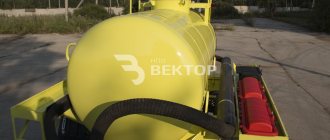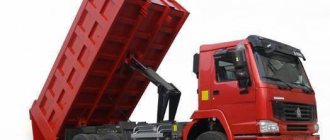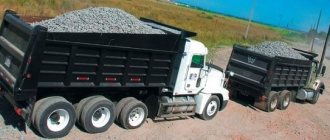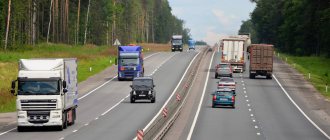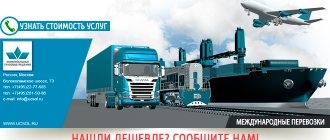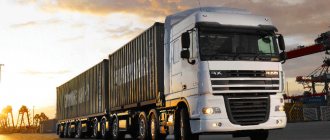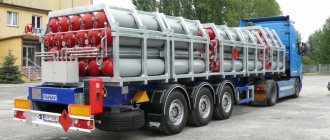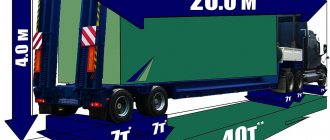Before deciding how and in what you should transport bulk materials, let's figure out what it is. This is the name given to particles of a small fraction (0.1–10 mm), homogeneous in composition. These include sand, cement, gravel with a fraction of 5–10 mm, crushed stone, mixed feed, peat and other materials with similar properties. Classification: bulk (homogeneous) materials. They are divided into granular, dusty and lumpy. The most convenient way is to order the transportation of bulk cargo by trawl or dump truck.
Transportation of bulk cargo by road
The rules for transporting bulk cargo by road are predominantly regulated by 2 documents:
If the Decree only indirectly touches on the topic of bulk cargo, highlighting the general conditions of cargo transportation, then the document inherited from Soviet times contains quite a lot of interesting information.
Rules from the “General Rules for the Transportation of Goods by Road” approved by the Ministry of Automobile Transport of the RSFSR:
- The conditions apply to the transportation of ores, construction materials, and metallurgical waste. Do not apply to agricultural cargo (paragraph 1).
- Loading of bulk materials must be carried out mechanically, with the condition that the weight of the load in one bucket is no more than one third of the permissible loading capacity of the platform. The minimum distance from the bottom of the body to the loading mechanism is 1 m (paragraph 2).
- At the time of loading, the driver must be outside the truck cab. The excavator operator is prohibited from moving the bucket over the dump truck cab (paragraph 3).
- The consignee is obliged to clear the body of cargo residues after complete unloading (paragraph 4).
- The procedure for filing for loading is stipulated by the parties in the annual contract, the method of indicating the installation location and the sound signals used for this are determined (paragraph 5).
- The shipper is obliged to comply with safety regulations by fulfilling the following conditions (paragraph 6):
- fencing the roadway located inside the quarry
- provision of sliders for truck wheels if the loading area is inclined
- prepare the road surface in a timely manner for the smooth movement of vehicles
- wet the road at the quarry to reduce dust
- control the content of concentrated gases within normal limits.
- Reception and delivery of bulk materials is carried out using weighing. If the recipient is unable to determine the weight, the reception can occur visually, based on the total volume. In some situations, the carrier may be exempt from delivering the cargo to the recipient, for example when removing snow (paragraph 8).
- Cargo transportation of homogeneous bulk materials is issued with one consignment note, which indicates the category “Transportation of cargo in bulk” (paragraph 9).
Screw conveyor
An auger, or screw conveyor, is a conveyor for fine bulk materials, which can be located either horizontally or in an inclined position.
The design also consists of a closed metal pipe, inside of which a shaft with helical blades is wrapped. When rotating, the raw material moves up the screw. Long conveyors are made of separate sections of 2-4 m each; the diameter of the chute can be from 10 to 60 cm. The advantages of such a conveyor are the ability to transfer raw materials with a lot of dust between closed systems. The disadvantage is wear of the metal body and crushing of raw materials during transportation.
In granulation lines, a screw conveyor is used before the pressing section
:
- for loading and unloading the drying drum (chips/shavings),
- feeding dry wood chips/sawdust to the rotary crusher,
- transfer of crushed raw materials to the granulator hopper.
In a feed mill line, augers are involved in transporting the initial components for crushing (if there is no pneumatic grain intake system), and also often connect the feed mixer and the granulator storage hopper.
Rules for the transportation of dangerous goods by road, safety requirements
Appendix 2. rules for transporting goods by road
In the event of an emergency, drivers must know how and in what sequence to act in order to eliminate the consequences. Drivers should also take all measures for their own protection as outlined in the emergency card. The main tasks in the event of emergency situations: first aid to those in trouble, evacuating people if necessary, finding a damaged container and removing it and the spilled substance, notifying the shipper's organization about what is happening.
- Explosives. An orange sign with a symbolic pattern of an explosion.
- Flammable gases. A red diamond with black or white flames in the background. Non-toxic and non-flammable gases - a picture of a cylinder on a green background.
- Flammable materials of subclass 4.1 - a sign painted in red and white stripes with a stylized image of a flame. Subclass 4.2. – a sign divided into two parts: red at the bottom, white at the top. There is a flame drawn on the white half. Subclass 4.3 – blue background and fire pattern.
- Oxidizing substances. A yellow diamond with a circle engulfed in flames;
- Subclass 6.1 – toxic substances, marked with a white sign with a “pirate” design of a skull and crossbones; Infectious substances from subclass 6.2 are also indicated by a white sign, but with the image of crossed months on it.
- Radioactive substances. The appearance of the diamond depends on the category, but there must be a design in the form of a black trefoil, and in the lower half of the sign the word “Radioactive” is written in large letters.
- Corrosive substances - their identification mark is made in the shape of a rhombus, the lower part of which is painted black, and on the upper, white half, test tubes are drawn, inclined towards a hand or an ingot of metal.
- Other substances from the ninth class are distinguished by a sign, the upper half of which is painted over with vertical black stripes, and the lower part is left white.
Nuances of a specialized area
Features of transportation of bulk cargo
Methods for sending standard bulk cargo differ from specialized ones according to a number of criteria. The latter set off only on special equipment. Due to the fact that the luggage is fragile, perishable, etc. It is imperative to adhere to all conditions for its preservation, even on the road.
Shipping in bulk of various non-standard materials and products differs in many respects from standard luggage. In this case, it is not enough to use an ordinary carriage or car body. For specialized bulk transportation, the contractor uses special containers, conveyors or platforms.
If bulk cargo is perishable, refrigerators are necessarily used for transportation, in which suitable temperature conditions can be set or air humidity can be controlled. Special trains require reliability, a convenient mechanism for loading, removing luggage and other means that can ensure high-quality transportation.
Special refrigerated containers are used to transport perishable goods by sea.
APPLICATION OF AN AIR GUTTER SYSTEM FOR TRANSPORTING CARBON MATERIALS
In the Electrode Production Shop, screw conveyors were used to transport cinder and coke dust, which require high operating costs and a low service life.
The accumulated experience in transporting alumina and the availability of a testing base made it possible to conduct tests on transporting carbonaceous materials. In 2006-2008 a system for transporting cinder and coke dust, as well as a system for transporting coke sorbent for the Dantherm filter, was designed, manufactured and launched.
On approval of the Rules for the transportation of goods by road
Transportation of goods3. estimated prices for transporting goods by road
325. When loading or unloading long and massive metal products using crane equipment, the driver is not in the cabin of the vehicle, and the consignor or consignee does not move the cargo above the cabin of the vehicle.
Use of vehicles with payment at a time-based rate (payment for the work of a vehicle is made on an hourly basis during one working day (shift), recorded in the waybill in form No. 4-p, in accordance with Appendix 1 to these Rules, indicating the mileage and time spent vehicle at the disposal of the consignor (consignee), minus the driver's lunch break time.
Rules and features of transportation of bulk cargo by dump trucks
Bulk materials widely used are divided into lump, dust and granular.
Dump trucks are designed for transportation of bulk cargo
Such cargo is transported mainly by enterprises of the mining, metallurgical, construction and agricultural industries. The first three actively use dump trucks for this, as well as special sealed vehicles (cement trucks).
In agriculture, sealed (flour) trucks predominate; The dusty and granular materials used in this industry (fertilizers and other chemicals) are supplied in sealed packaging (bags, barrels, drums) and transported by any means of transport.
The use of dump trucks for bulk transportation of such cargo is profitable and convenient, especially unloading from the body. However, their use has mandatory rules and restrictions aimed at preventing damage to humans and nature and preserving the road surface.
These rules are different when transporting bulk cargo on public roads of all levels and on roads in the territories of industrial enterprises.
Public roads
When using dump trucks to transport bulk cargo on public roads in bulk, each vehicle must have a stretchable awning made of dense material.
The awning must be securely attached to the body and completely cover the material transported in bulk on all sides.
The absence of an awning is allowed when the body is loaded with material not higher than the level of its sides; in this case, the car body must be equipped with a canopy made of the same fabric as the awning, and tightly cover the cargo transported in bulk.
Such rules are necessary to prevent spillage of transported material when the vehicle is moving. Cargo transported in bulk has a chemical composition that is unsafe for humans, animals and nature.
Solid pieces of such cargo damage the road surface and can be thrown from under the wheels into an oncoming vehicle. Violation of the rules for covering bulk cargo can lead to serious accidents.
In addition, these rules prevent the loss of part of the cargo, that is, they are economically beneficial.
Violators face serious fines for non-compliance with the rules. This applies to:
- driver as an individual;
- its manager as an official;
- enterprise as a legal entity.
If violations are repeated, the consequences for the enterprise are even more serious - they can stop transportation. It is impossible to quickly switch to another mode of transport; suppliers of raw materials will be overstocked with products, and processors will be left without raw materials. But these are enterprises with a continuous production cycle; the lack of raw materials will cause technological disruptions, even accidents.
The body does not need to be covered with an awning if it is not filled to the top
Roads of industrial enterprises
On the territory of industrial enterprises, transportation of bulk materials for technological needs in bulk is allowed without covering the cargo in the back of a dump truck. If transportation is carried out on the roads of populated areas (if the divisions of the enterprise are located separately or if there are several entrances to the territory of the enterprise), then the rules of transportation on public roads are followed.
Bulk materials are loaded in bulk into the vehicle body using a mechanized method. The weight of the material in the bucket of an excavator or loader should not exceed 1/3 of the capacity of the body. The driver must leave the cab when loading; The loaded bucket should not move above the cab.
Cargo is unloaded at the destination point at the location indicated or marked with a sign. If reversing is used, a sound signal sounds. After unloading, the car body is cleared of any remaining material being transported.
When transporting materials from quarries, the road from the lower ledge is fenced with an obstacle that is insurmountable for a car (an embankment of waste rock). Roads must be cleared of spilled materials and snow; Water in summer to prevent dusting.
There must be a procedure for stopping access to the quarry during blasting operations.
For non-compliance with the rules for the transportation of bulk cargo, the legislation of the Russian Federation provides for a fine. All major errors are indicated in Article 12.21 of the Code of Administrative Offences. They boil down to the fact that the carrier is responsible for the correct placement of the cargo.
Rate this article: Loading...
Oversized cargo - general information
The oversized category includes cargo of any non-standard shape if its dimensions exceed those allowed by technical standards. It is impossible to transport such objects in a regular container, or by traditional freight transport.
In addition, the group of oversized items includes items whose dimensions are larger than the dimensions of the vehicle. In such a situation, transportation is dangerous as the likelihood of an accident increases. Such objects are classified into a separate category, for which specific transportation requirements have been developed.
The main condition for safe transportation is that the process should be organized so that all traffic participants promptly notice the transport and the cargo on it, and accordingly take the necessary precautions
Large objects are usually divided into several categories:
- large - the cargo exceeds the size of the selected transport, this creates the likelihood of congestion and road blocking;
- heavy - the cargo is too heavy, its weight exceeds the limit established for a particular type of transport.
Large products - permissible dimensions:
- width - exceeds 2.55 m;
- length - exceeds 16 m;
- height - exceeds 4 m.
Any cargo whose dimensions and weight do not correspond to the established limits is called oversized. Transportation of such objects is more expensive compared to transportation of other products.
As a rule, the list of oversized cargo includes: water transport, large agricultural machinery, any non-standard-shaped structures, machine tools, equipment for industrial facilities. Reinforced concrete and concrete products, as well as any cargo that cannot be transported closed.
To transport oversized cargo of non-standard shape, you will need a low-loader platform - after installation on it, the load becomes lower. If the load is too heavy, it is placed on an additionally reinforced platform of the required carrying capacity with an increased number of axles.
Economic indicators
The energy consumption for transporting 1 ton of material per 1 meter for our gutters does not exceed 10 W, while for foreign analogues it is 3 - 4 - 10 times more.
The metal consumption of our CRG systems is 30–50% lower than that of imported analogues. The utilization rate of air gutter fabric for a 150mm wide air gutter is 90%.
Table 2. Comparison of technical and economic indicators of ToxSoft air chutes and foreign analogues
| Index | Air chute "ToxSoft" | Aerochute, foreign analogue |
| Productivity, t/h | 30-40 t/h | 20-30 t/h |
| Tilt angle % | 1 | 1 |
| Specific energy consumption, | 4- 10 W/(t*m) | 130-300 W/(t*m) |
| Compressed air consumption for transportation | No | No |
| Line cross section | Box 156 x 326 mm | Box 300 x 650 mm with flanges and “satellite” pipe 250 – 300 mm |
| Porous partition material | Special fabric for air chutes | Special fabric for air chutes |
| Blowing complex | Local blowers, 1 per 16 - 20 m main air chute with a rated power of 0.5 kW or 6.4 kW per main chute 250 m long | Centralized blowing complex with redundancy, power 55 kW. |
| Air duct | Not used | “Satellite” pipe with a diameter of 250 -300 mm along the entire length of the air chute |
| Alumina abrasion | Minor | Minor |
| Possibility of filling several baths | Refills several baths at the same time | Refills several baths at the same time |
Calculation of machine needs
Determining the required type of transport occurs at the first, preparatory stage, this was already mentioned a little earlier. In this case, we will talk about calculating the needs of cars.
Sometimes, in order to carry out fast and high-quality transportation, you may need the service of several vehicles capable of delivering the required amount of cargo to a construction site at periodic intervals.
Read about transporting children on a motorcycle here.
Another situation involves the opposite requirements, for example, the rapid transportation of crops from a warehouse to another facility. Therefore, each situation must be approached with a full analysis of what is happening, taking into account not only financial criteria, but also the properties of the material.
INTRODUCTION TO TECHNOLOGY
The design of the air chute has been known for a long time and is used in various industries. An air chute is a pipe of round or rectangular cross-section divided along the height into two cavities by a porous partition. The upper cavity is for transporting material (cement, grain, and other bulk or powdery substances), and the lower cavity is for supplying blow air into it. When the blast air passes through the porous partition and the material, the latter “liquidizes”, i.e. acquires properties close to liquid, which allows it to move according to its laws.
The width of the material cavity and the amount of blowing air, as well as the angle of inclination of the air chute, determine its performance. To reduce construction and operating costs, it is necessary to clearly correlate the dimensions of the air chute with its performance. Excessive productivity leads to unreasonable costs. Typically, the air chute should provide 30-50 tons per hour.
The porous partition must have pores of such a size that the material does not enter not only into the blow cavity, but also does not penetrate into the partition itself, clogging it.
Also, the porous partition must be sufficiently durable and not change its properties during operation.
How did shipping by containers come about?
Delivery of goods in special boxes appeared back in the 20s of the last century. But their use was not relevant, and they were forgotten. Only since the 60s, with the rapid growth of cargo turnover, it became obvious that only transportation in containers can reduce loading/unloading time when using heavy-duty types. This was the impetus for their use not only for sea transportation. They are easily reloaded onto railway platforms, on board a car and even onto an airplane.
Modern delivery of various goods from the sending company to the recipient is carried out in standardized containers (intermodal containers), the dimensions of which are the same for all countries.
The use of this type of transportation has led to the development of a new direction in servicing customers - container logistics, which organizes the delivery of goods, minimizing the process itself and reducing delivery costs.
Rules for the transportation of bulk cargo
What does transport legislation require? According to it, transportation of bulk cargo can be carried out by road, rail and water transport, and the requirements for transportation are determined by the specific type of bulk cargo and its physical properties (density, volume, weight, flowability, environmental safety, natural temperature of the material, etc.).
The rules for the transportation of bulk cargo are regulated by the transport legislation of each country and international carrier associations. It is necessary to know them, since for violations of safety regulations when transporting this type of cargo, you can receive quite sensitive fines.
Noria
A bucket belt elevator, or elevator, is a vertically installed closed belt with buckets along its entire length. The buckets continuously move in a circular motion up and down: they pick up loose loads at the bottom, lift them to the top and, turning over the head, pour the contents into the receiving hopper. You can read more about this device in our article on grain elevators.
Norias are installed on the pellet/mixed feed line when it is necessary to deliver the load vertically to a greater height. In most cases, elevators are used to move finished granules from a cooling column into a filling dispenser container.
Features of elevators from ALB Group
:
- The modular design of elevators from ALB Group allows them to be easily modified to suit the Customer’s conditions.
- Buckets are made of ST-3 steel, but they can also be made of stainless or galvanized steel.
- A BCNL tape or a food belt with plastic or metal buckets to choose from is installed.
- Optional installation of a tape derailment control device (UKSL).
Additional types of transportation
Unimodal is a type of transportation that is carried out by one type of vehicle. The type of object, its size, transportation time and costs are taken into account.
Mixed - freight transportation carried out by several types of vehicles.
Combined - transportation of cargo by more than two types of transport
Intermodal - delivery of cargo among several types of vehicles, the organization of delivery of goods to the final point of arrival is entrusted to one of the carriers. Responsibility in this case is divided depending on the modes of transport.
Multimodal - imply the presence of one responsible person, regardless of how many types of vehicles are involved.
In order to significantly save time, money and use maximum productivity, even special routes are currently being developed. Let's get acquainted with the three main ones.
- Pendulum. The essence of this route is that delivery is carried out to the destination and back, the availability of cargo is ensured in both directions.
- Annular. The route is carried out in a closed ring, consisting of several points: cargo must be delivered to some, and picked up from others.
- Prefabricated or disassembled. The route consists of certain points where you need to pick up the cargo; as the goods are received, the vehicle is fully loaded, and then unloaded in the same gradual manner.
Having examined all types of freight transportation, we can say that each of them has its own positive and negative sides. A person has the right to choose the delivery option that is convenient and acceptable
It is worth paying attention to the company that provides services. Don’t chase sweet prices, look at the quality and reputation of the company so that the cargo remains safe and sound
The difference between bulky cargo
There are several concepts that define large and heavy loads. It is easy for an ignorant person to get confused in them. So, a more general concept is “oversized cargo”. It is also sometimes called non-standard.
In more simple and understandable terms, oversized cargo is a heavy or bulky item (sometimes both) that cannot be transported in the usual way in a container or closed vehicle. An example of such cargo can be agricultural machinery, drilling equipment, transformers, and so on.
Due to the wide variety of types of oversized cargo, the need for classification arose. They are divided into the following types:
- Heavy, which, after loading onto a vehicle, causes the permissible parameters for weight or axle load to be exceeded.
- Large cargo that causes the overall dimensions of vehicles to be exceeded.
- Long, which, after loading onto a vehicle train, protrudes beyond its tailgate by more than 2 meters.
Large and heavy cargo is difficult and very expensive to transport by air and rail. Therefore, road transport is most often used.
conclusions
When choosing a specific method for transporting bulk materials, they rely on the following parameters:
- The convenience of using this particular method. Angles and turns.
- Geometric dimensions and weight of the material.
- Possible susceptibility to shredding.
- Cost of transportation.
- Material delivery range.
If it is necessary to deliver bulk material to a length of 2 - 5 meters in a straight line from point A to point B over a short distance, the solution would be to install an auger. Under similar conditions but with a length of 6 - 30 meters, a conveyor belt will work well. When transporting cargo with a vertical angle, you can install a scraper conveyor. But if it is necessary to move material over a long length of more than 30 meters, then pneumatic transport may be a good solution.
Good luck and see you again!
Transportation
Transportation in bulk is carried out without the use of packaging. Loading bulk materials involves them falling from a certain height, which should not affect the quality of the goods. Work of this type has features and nuances, these include:
- Prohibition on combining different types of luggage in one vehicle.
- Refusal to openly transport various types of materials that release toxic substances.
- Prohibition on transporting dry substances in an open body, which implies the formation of a cloud of dust.
- Carrying out loading using mechanisms in which the volume of the bucket does not exceed a third of the size of the vehicle body. The height of the fall should not exceed 0.5 meters, otherwise it is possible to cause a breakdown of the vehicle, namely failure of springs, airbags, etc.
- In advance, according to the contract, the customer and the contractor discuss the moment of cleaning the car body from the remnants of the transported substance.
When filling any types of bulk materials, the driver leaves the vehicle body to avoid possible injuries. Filling the body should never be carried out through the cab; this process is carried out from the rear or side of the body. When the vehicle is ready for departure, the excavator operator will give the driver a specific signal using headlights or a signal sound.
The customer provides the driver for the transportation of bulk substances with complete safety in the area where the work will take place. Both reception and delivery of bulk materials are carried out according to the weight indicated in the documentation.
Sending bulk materials requires compliance with general requirements, but if we are talking about coke, then it is worth considering that with increased humidity, this porous material swells and increases its mass by a quarter.
To ensure high-quality movement of any type of cargo, including bulk cargo, a logistics company must have a large fleet of vehicles.
Please note the availability of vans and trailers with different characteristics, body volume and thermal properties
Only one type of bulk cargo can be transported in one vehicle
DESCRIPTION OF THE TsRG SYSTEM AND ITS UNITS
Taking into account the above, I tried to design and build a DRG system that is devoid of the listed disadvantages.
Air chute section design
Porous partition
In the late 90s and early 2000s, it was not possible to purchase specialized air gutter fabric in Russia, or its cost was so significant that it increased the cost of the gutter to an unacceptable amount.
In 1998, tests were carried out on the use of porous stainless steel as a porous partition, which is used in the chemical industry. The cost of this material was significantly lower than the cost of specialized air gutter fabric made in Italy or Germany. As tests have shown, the properties of porous stainless steel allow it to be used in air chutes, and at very high temperatures up to 450 degrees.
Two methods of fastening porous stainless steel to the air chute section were tested: Welding and clamping in a profiled rubber seal. For high-temperature air chutes, a welded connection is used, and for gutters operating at low temperatures, clamping in a rubber seal is used.
Such air chutes were first built by the company in 2001 at the Nadvoitsky aluminum smelter, at an alumina warehouse and in 2003 - 2004 for 16 pots with baked anodes (127 m), also in 2004 in the 8th building of the Sayanogorsk aluminum smelter (experimental pots RA -300, total length of the air chute –
130 m).
Fig.4.
TsRG system "ToxSoft" in the NAZ building Despite the fact that air gutter fabric has become available, a porous partition made of stainless steel is currently used in other projects where high temperatures are present.
When using air gutter fabric, the company's specialists could not afford to waste this expensive fabric. An original method of stretching fabric was developed and patented.
Its essence is that after stretching the fabric in the longitudinal direction, the fabric is also stretched in the transverse direction when connecting the material and blow cavities. For this purpose, a special profile is made in the cavities, which pinches and stretches the fabric in the transverse direction. The fabric consumption for the longitudinal clamp is 7.5 mm per side, and the width of the air channel at the junction of the cavities increases by only 3-4 mm, instead of 80-100 mm with flange tightening. Clamps are used to connect the cavities of the section. The distance between the clamps is 250-350 mm, and 10-14 pieces are required for a section 4 m long. Tensioning the fabric in the longitudinal and transverse directions made it possible to reduce the load on the section structure, and, therefore, made it possible to use less thick sheet metal. Instead of 3-4 mm in a traditional gutter, sheet metal was used - 2 mm, which reduced the weight of the section by 30-45%, and the weight of a 4-meter long section was 65-70 kg.
Local blowing systems
The company chose the modernization of existing aluminum smelters, built in the 30s - 60s of the last century, as the main direction in creating DRG systems. At these plants, not only is there no space for the passage of the central heating plant, but all the free space is overgrown with other equipment (gas ducts, cable routes, auxiliary equipment, etc.). There is a catastrophic lack of space for laying the main chute, and even more so for the “satellite” air duct.
To solve this problem, domestically produced low-power local blowing units AB-1000 were tested, with direct connection to the blast cavity of the gutter. A special feature of these units is the ability to develop pressure from 80 to 1200 mm. water column with relatively small volumes of pumped air 20-65 liters/sec.
Fig.5. Blowing complex
In one blowing complex (Fig. 5.) two such units are used, with sequential electrical connection. This allows for double redundancy, i.e. When one unit fails, the second one is switched on at full power, which ensures normal loading, and information about the engine malfunction is transmitted to the operator.
The blowing complex on AB-1000 units ensures the transport of alumina along a transport module 16-20 meters long. The transport module is an independent energy-independent technological unit, equipped with a block of blowing fans, a pressure sensor in the blow cavity and pressure relief filters.
With the advent of more powerful units (1300-2000 W) on sale, the length of the transport module with a common blast increased to 25-35 m. In the first cases of using local blast complexes, they were controlled from a central control cabinet. This required a large number of cable products to control the blowing units and to take readings from pressure sensors. But, despite these disadvantages, significant advantages of local blowing have also emerged. This made it possible to algorithmically determine loaded areas, identify alumina “plugs” and the ability to eliminate them automatically, and carry out selective loading of electrolyzers.
The ability to turn off the blast of areas that do not need loading made it possible to significantly (40-60%) reduce the energy consumption for operating the system relative to systems with centralized blast.
Bulk transport control unit (BUTS)
Fig.6.
Board and BUTS assembly To reduce the use of cable products and to smoothly and accurately adjust the performance of blowing units, the so-called “Bulk Transport Control Unit” (BUTS) was developed. Since power supply is available at each electrolyser, it was decided to power the local blowing complexes from existing equipment and control them via the network. Thus, the BOOTs are connected to each other using only one network cable.
The BUTS is built on the basis of a programmable PIR processor, which controls the power of two blowing units from 5 to 100% of their rated power.
The BUTS has six discrete inputs, two analog inputs, three discrete outputs, and is also equipped with pressure sensors. Table 1. Technical characteristics of the bulk transport control unit (BUTS)
| Parameter name | Meaning |
| Overall dimensions, mm | 471x421x270 |
| Degree of protection against environmental influences according to IEC529 | IP66 |
| Operating temperature range, °C | -40 ÷ +50 |
| Relative air humidity, without condensation, % | up to 95 |
| Atmospheric pressure, kPa | 84 – 106,7 |
| Supply voltage | 220±10%, 50Hz±2% |
| Maximum power consumption, W | 20 |
| Number of channels: | |
| motor control (=220V) | 2 |
| valve control (~220V) | 3 |
| pressure measurements | 3 |
| insulation monitoring | 4 |
| digital inputs | 6 |
| discrete outputs | 3 |
| Pressure measurement range, kPa | 0,1…10 |
| Pressure measurement accuracy in the temperature range 0…80ºС | ±5% |
| Maximum power of connected motors, kW | 2 to 1 channel |
| Maximum power of connected valves, W | 400 per 1 channel |
| Maximum load of output channels, mA | 20 per 1 channel |
| Insulation monitoring threshold, kOhm | 2…50 |
| Cycle of polling controlled parameters and issuing control actions, sec, no more | 1,0 |
| Information transfer rate via RS-485 interface, bit/s | 9600..115000 |
Based on the data received from pressure sensors, calculations are made about the presence of alumina “plugs”, about the filling of the chute and hoppers of the APG with alumina, and the time of switching on and off the required section of the chute.
The BUTS controls unloading devices in its section of the central heating group, turns on or off other equipment, monitors the performance of blowing units, and also measures the insulation resistance of structural elements relative to the “ground”, if such measurements are needed.
Automation of the TsRG system operation
provides developed CRG systems with a full complex of automated process control systems. This includes BUTS programming, development, manufacturing and programming of lower level, upper level programming, and, if necessary, adaptation or implementation of automated process control systems into systems operating at a particular plant.
Fig.7. Simplified block diagram of the automated process control system of the CRG system
Structural units
5.1. Air chute sections
When developing sections of the air chute, maximum unification was envisaged - modularity
.
Based on the results of calculations and tests, the cross-sectional dimensions of the main and distribution gutters were determined. So the cross-section of the main gutter is 150 x 330 mm, the length of the section is 4000 mm (along the connecting flanges). The length was chosen based on the following considerations:
- length is a multiple of the distance between building structures;
- production capabilities;
- the length allows loading into a standard container for transportation to the customer.
The distribution chutes for loading APG bunkers have a cross-section of 100 x 250 mm, their length is also 4000 mm. If the project requires a different length, then a special section is made.
Currently, a universal design of blowing complexes has been developed, they minimize overall dimensions, and also unify the fastening to both the main chute and the distribution chutes.
5.2. Unloading device
Fig.8.
Unloading device An unloading device has been developed to unload alumina from the silo into the main air chute. Unlike traditional bottom unloaders that have a gate, which requires significant effort to open, our design makes it possible not only to easily shut off the flow of alumina, but also to very finely regulate the amount of alumina coming out. The device also has a trap for foreign objects in the alumina. The unloading device has aeration and acceleration cards, which improve conditions for the flow of alumina, both through the device itself and at the beginning of the chute.
Some projects use an unloading device with the ability to remotely automatically control the flow of alumina based on aerodispensers. An unloading device that does not contain mechanical components is under development. This unloader is capable of operating at high pressure drops, both at the inlet and outlet.
Oversized cargo is
Oversized cargo, also known as large cargo, also known as heavy cargo, is one whose weight and overall dimensions exceed the permissible standards established by the ministry of a particular country.
The Russian Federation Traffic Regulations establish the following parameters for oversized cargo:
- If the luggage exceeds the dimensions of the car by more than 1000 cm.
- If on the sides the load protrudes more than 40 cm from the side lights of the car.
Traffic regulations on the transportation of goods
Clause 23.5 of the traffic rules informs that a vehicle transporting oversized cargo must be marked with the sign “Large cargo”. In addition, in the evening, that is, from the beginning of evening twilight to the beginning of morning twilight, and in the daytime in conditions of poor visibility, a reflective element or white light must be installed in front of the vehicle, and a reflective element or red light must be installed in the rear . These rules are sufficient for driving on public roads.
https://youtube.com/watch?v=DsTYXUxKpLQ
Special requirements for cargo transportation
State authorities have established special standards for the transportation of explosive, chemical, flammable and other dangerous goods, long, oversized, heavy cargo.
Special rules that must be followed when driving a vehicle with or without cargo:
- If the height of the Vehicle is more than 4 meters from the road surface.
- If the vehicle width is more than 2.55 meters. For refrigerated trailers (freezers) and isothermal bodies, the permissible width is no more than 2.6 meters.
- If the length of a road train with one trailer is more than 20 meters.
- If the length of a road train with two or more trailers is more than 24 meters.
- If the overall dimensions of the transported cargo exceed the dimensions of the vehicle by 2 meters (in height and width).
- If the height of the Vehicle is more than 4 meters from the road surface.
- If the vehicle width is more than 2.55 meters. For refrigerated trailers (freezers) and isothermal bodies, the permissible width is no more than 2.6 meters.
- If the length of a road train with one trailer is more than 20 meters.
- If the length of a road train with two or more trailers is more than 24 meters.
- If the overall dimensions of the transported cargo exceed the dimensions of the vehicle by 2 meters (in height and width). Additionally, if the cargo is oversized, you need permission from the traffic police. The main value is the weight of the vehicle along with the cargo being transported.
If the route for transporting oversized cargo takes into account crossing the border of States, then it is necessary to comply with the requirements of the laws of the country in which the cargo is transported.
- Two-axle vehicles with a load, if their weight is more than 18 tons.
- Three-axle vehicles with cargo, if their weight is more than 25 tons.
- Four-axle vehicles with cargo, if their weight is more than 32 tons.
- Three-axle road train with cargo, if their weight is more than 28 tons.
- Four-axle road train with cargo, if their weight is more than 36 tons.
- Five-axle road train with cargo, if their weight is more than 40 tons.
- A six-axle road train with cargo, if its weight is more than 44 tons.
No less stringent standards are the distribution of weight along the axles. Both the distance between the axles and the road load standards are important. Standards for permissible loads on roads are established during the design and construction of roads, for example, there is a permissible load on one axle of 10 tons, 6 tons, 11 tons, 5 tons, etc. Based on the mass on the axle, a route is laid out. Therefore, truck drivers have to drive not along the short route, but along the permitted route.
“Oversized cargo” sign “Long road train” sign “Long vehicle” sign If a vehicle transports cargo that is classified as dangerous, then the following sign must be installed on it: Which goods are considered dangerous. See classification:
UNIQUE TECHNICAL SOLUTIONS
always tries to fulfill the customer's wishes. It happened that there were no ready-made solutions that met the customer’s requirements. ToxSoft specialists carried out engineering research, which resulted in the creation of unique technical solutions. Thus, for the experimental section 8 of the SAZ building for the RA 300 electrolyzers, a mechanism for moving the dispensing chute was developed. This mechanism is needed in case of repair of the APG system, since during the design of the electrolyzer there was no provision for placing the distributing air chute.
| Fig.9. Distributing chute with a moving mechanism in building No. 8 of the Sayanogorsk aluminum smelter | |
| Rice. 10. CRG system for electrolyzers with continuous processing – Volkhov Aluminum Plant | |
| Rice. 11. Design of the APS of the KrAZ pilot site | |
| Rice. 12, 13. Air chutes for transporting cinder and coke dust in the mixing and pressing department of the SAZ CPE |
For the Volkhov aluminum smelter, a CRG system for electrolyzers with continuous processing was designed, manufactured and launched. Previously, alumina was delivered to these baths by electric trucks with gravity-fed bunkers. And now, from the main air chute, alumina is discharged along a sleeve with dy = 80 mm directly onto the electrolyzer crust (system for 20 electrolysers). The alumina flow is controlled using an original unloading device that does not contain mechanical parts or valves.
Electrolyzers with baked anodes and with lateral current supply have a stationary anode design, which greatly facilitates the design of CRG systems for them. Electrolyzers with top current supply, which are the majority in Russia, stand apart. The movable anode structure significantly complicates the design of the articulation of the main, distribution chutes and the anode device. together with RUSALA Research and Development Center, a so-called system was designed. automatic supply of raw materials (APS) for electrolyzers at the KrAZ pilot site (joint patent with RUSAL Research and Development Center).
The system transports fluorinated alumina from the intermediate shell bunker to 5 electrolyzers and then to the APG bunkers. To eliminate moving elements in the distribution chute, it was proposed to install 4 stationary intermediate bins on stands directly on the cathode of the electrolyser. The capacity of intermediate bunkers is about 250-300 kg, i.e. their total capacity is ~ 1800 kg. These bunkers must be refilled 2-3 times a day, which guarantees the required daily consumption of alumina by the electrolyzer at 155-160 kA. Alumina from intermediate bunkers is supplied through a system of vertical movable joints to air tracks, and then to APG bunkers mounted on the anode casing. After testing this design, an evolutionary transformation of the design followed. Only the punch of the APG system was left on the anode casing, and alumina is dosed directly from hoppers installed on racks.
Organization of transportation
To eliminate the occurrence of interference and unusual situations during the transportation of oversized cargo by road, careful organization is necessary.
This process includes the acquisition of additional access, approval of the declared route with the necessary authorities, as well as calculation of the cost of the upcoming campaign.
Transportation permit
Obtaining a permit for the transportation of oversized cargo consists of three stages:
- Submitting an application.
- Preparation and submission of the necessary documentation for vehicle ownership, cargo, etc.
- Payment of state duty. Since January 2015, the fee has been stable - 1,600 rubles.
After completing these steps, all that remains is to sign for a transportation license and reflective signs for the cargo. The validity period of such a permit is usually 3 months. Detailed information can be found in Order No. 258 of the Ministry of Transport of the Russian Federation dated July 24, 2012.
Route coordination
Before the start of transportation, a road train route plan is drawn up, which is agreed upon with the traffic police department, the department of the Russian Road Administration, and other supervisory authorities.
When coordinating the itinerary plan, attention is paid to all possible nuances. This approach will avoid causing interference to other road users and delays along the way.
Cost calculation
When preparing for the transportation of oversized cargo, the cost of the upcoming campaign is preliminarily calculated. The budget for such transportation depends on several factors. For example, transporting long cargo is often cheaper than bulky cargo.
Be sure to take into account:
- distance;
- dimensions and weight of the cargo;
- delivery terms;
- need for support;
- damage to the roadway surface (if axial loads are exceeded).
Based on these conditions and knowing the prices of the selected carrier company, it is easy to calculate the preliminary cost.
